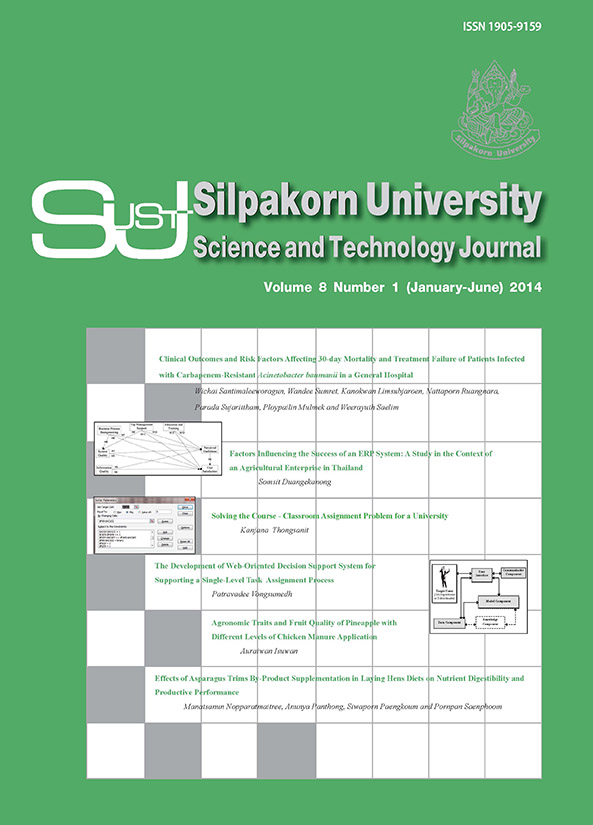Agronomic Traits and Fruit Quality of Pineapple with Different Levels of Chicken Manure Application
Main Article Content
Abstract
The responses of the pineapple (Ananas comosus (L.) Merr cv. Pattavia) grown in a fine-silty soil to various levels of chicken manure, in terms of plant growth, and fruit yield and quality, were investigated at a farm plantation in Petchaburi, Thailand. A randomized complete block design with 4 replications was used. Treatments were the chicken manure applied in levels equivalent to 0 (control), 3, 6 and 9 g nitrogen (N) plant-1. The manure was manually and thoroughly mixed with the soils, which was incubated for 30 days prior to pineapple planting. Agronomic traits of the pineapple plants and chemical composition of the pineapple fruits were determined. Plant growth and fruit size were linearly increased (p<0.05) with the increased manure levels. Fresh fruit weight from the highest level of manure application was 60% higher than that of the control treatment. Similarly, citric acid and vitamin C contents were linearly increased (p<0.05) as the manure rates increased. It can be concluded that growth and yield of the pineapple positively respond to increased chicken manure application. In terms of productivity, the moderate application rate of chicken manure cannot yet be recommended because curvilinear response has not been detected in this study. Therefore, further study with respect to a wider range of application rate is required to find out the most appropriate rate.
Downloads
Article Details
References
AOAC. (1990). Official Methods of Analysis of AOAC International. 15th ed., Association of Official Analytical Chemists, Washington, DC.
AOAC. (2000). Official Methods of Analysis of AOAC International. 17th ed., Association of Official Analytical Chemists, Gaithersburg, MD.
Brar, B. S., Singh, K., Dheri, G. S. and Balwinder-Kumar. (2013). Carbon sequestration and soil carbon pools in a rice-wheat cropping system: Effect of long-term use of inorganic fertilizers and organic manure. Soil & Tillage Research128: 30-36.
Bray, R. H. and Kurtz, L. T. (1945). Determination of total, organic, and available forms of phosphorus in soils. Soil Science, 59: 39-46.
Bremmer, J. M. and Mulvaney, C. S. (1982). Nitrogen total. In Methods of Soil Analysis: Agron (Page, A. L. ed.), No. 9, part 2: Chemical and Microbiological Properties. Am. Soc. Agron. Madison, WI.
Daramola F. Y., Afolami S. O., Idowu A. A. and Odeyemi I. S. (2013). Effects of poultry manure and carbofuran soil amendments on soil nematode population and yield of pineapple. International Journal of Agri Science, 3: 298-307.
Havlin, J. L., Beaton, J. D., Tisdale, S. L. and Nelson, W. L. (2005). Soil Fertility and Fertilizers; An Introduction to Nutrient Management. Pearson Education, Inc. New Jersey.
Hepton, A. (2003). Cultural system. In The Pineapple; Botany, Production and Uses (Barthomew, D. P., Paull, R. E., Rohrbach, K. G. eds.), pp: 109-142.
CABI Publishing. Oxon, UK. Hesse, P. R. (1971). A Textbook of Soil Chemical Analysis. John Murray. London.
Hodge, J. E. and Hofreiter, B. T. (1962). Method in Carbohydrate Chemistry. In Determination of Reducing Sugar and Carbohydrate (Whistler, R. L., Be Miller, J. N. eds.), Academic Press. New York.
Isuwan, A. (2007). Effect of pineapple cropping on soil chemical and physical changes in tha-yang soil series, Petchaburi province. Songklanakarin Journal of Science and Technology, 29: 297-305.
Isuwan, A. (2008). Effects of soil moisture and microbial inoculation on crotolaria mucronata decomposition and soil fertility. In Proceedings of 2nd Silpakorn University Research Fair, Thapra, Bangkok. pp. 273-277.
Jackson, M. L. (1958). Soil Chemical Analysis. Prentice Hall, Inc. N. J.
Liu, C. H., Liu, Y., Fan, C. and Kuang, S. Z. (2013). The effects of composted pineapple residue return on soil properties and the growth and yield of pineapple. Journal of Soil Science and Plant Nutrition, 13: 433-444.
Malezieux, E. and Bartholomew, D. P. (2003). Plant Nutrition. In The Pineapple; Botany, Production and Uses (Barthomew, D.P., Paull, R. E., Rohrbach, K. G. eds.), pp. 143-166. CABI Publishing. Oxon, UK.
Mclean, E. O. (1982). Soil pH and lime requirement. In Methods of Soil Analysis: Agron (Page A.L. ed.), 2nd ed., pp. 199-224. No. 9, part 2: Chemical and microbiological properties. Am. Soc. Agron. Madison, WI.
Maillard, E. and Angers, D. A. (2013). Animal manure application and soil organic carbon stocks: a meta-analysis. Global Change Biology doi: 10.1111/gcb.12438.
Muller, K. E. and Fetterman, B. A. (2003). Regression and Anova: An Integrated Approach Using SAS Software: Joinly-copublished by John Wiley & Sons Inc. and SAS Institute Inc. Cary, NC.
Omotoso S. O. and Akinrinde, E. A. (2013). Effect of nitrogen fertilizer on some growth, yield and fruit quality parameters in pineapple (Ananascomosus L. Merr.) plant at Ado-Ekiti Southwestern, Nigeria. International Research Journal of Agricultural Science and Soil Science, 3: 11-16.
Peech, M., Alexander, L. T., Dean, L. A., and Reed, J. F. (1947). Method of Soil Analysis for Soil Fertility Investigations. US. Dept. Agric. Circ. Washington, DC.
Richards, L. A. (1954). Diagnosis and Improvement of Saline and Alkali Soil. USDA Agric. Washington, DC.
Spironello, A., Quaggio, J. A., Teixeira, L. A. J., Furlani, P. R., and Sigrist, J. M. M. (2004). Pineapple yield and fruit quality effected by npk fertilization in a tropical soil. Revista Brasileira de Fruticultura, 26: 155-159.
Walkley, A. (1947). A critical examination of a rapid method for determining organic carbon in soils-effect of variations in digestion conditions and of inorganic soil constituents.Soil Science, 63: 251-264.


